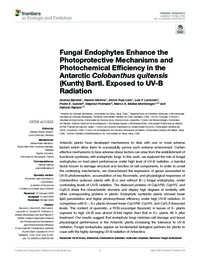Mostrar el registro sencillo de la publicación
Fungal endophytes enhance the photoprotective mechanisms and photochemical efficiency in the Antarctic Colobanthus quitensis (Kunth) Bartl. Exposed to UV-B radiation
| dc.contributor.author | Barrera, Andrea | |
| dc.contributor.author | Hereme, Rasme | |
| dc.contributor.author | Ruiz-Lara, Simon | |
| dc.contributor.author | Larrondo, Luis F. | |
| dc.contributor.author | Gundel, Pedro E. | |
| dc.contributor.author | Pollmann, Stephan | |
| dc.contributor.author | Molina-Montenegro, Marco A. | |
| dc.contributor.author | Ramos, Patricio | |
| dc.date.accessioned | 2020-12-11T19:14:20Z | |
| dc.date.available | 2020-12-11T19:14:20Z | |
| dc.date.issued | 2020 | |
| dc.identifier.uri | http://repositorio.ucm.cl/handle/ucm/3351 | |
| dc.description.abstract | Antarctic plants have developed mechanisms to deal with one or more adverse factors which allow them to successfully survive such extreme environment. Certain effective mechanisms to face adverse stress factors can arise from the establishment of functional symbiosis with endophytic fungi. In this work, we explored the role of fungal endophytes on host plant performance under high level of UV-B radiation, a harmful factor known to damage structure and function of cell components. In order to unveil the underlying mechanisms, we characterized the expression of genes associated to UV-B photoreception, accumulation of key flavonoids, and physiological responses of Colobanthus quitensis plants with (E+) and without (E−) fungal endophytes, under contrasting levels of UV-B radiation. The deduced proteins of CqUVR8, CqHY5, and CqFLS share the characteristic domains and display high degrees of similarity with other corresponding proteins in plants. Endophyte symbiotic plants showed lower lipid peroxidation and higher photosynthesis efficiency under high UV-B radiation. In comparison with E−, E+ plants showed lower CqUVR8, CqHY5, and CqFLS transcript levels. The content of quercetin, a ROS-scavenger flavonoid, in leaves of E- plants exposed to high UV-B was almost 8-fold higher than that in E+ plants 48 h after treatment. Our results suggest that endophyte fungi minimize cell damage and boost physiological performance in the Antarctic plants increasing the tolerance to UV-B radiation. Fungal endophytes appear as fundamental biological partners for plants to cope with the highly damaging UV-B radiation of Antarctica. | es_CL |
| dc.language.iso | en | es_CL |
| dc.rights | Atribución-NoComercial-SinDerivadas 3.0 Chile | * |
| dc.rights.uri | http://creativecommons.org/licenses/by-nc-nd/3.0/cl/ | * |
| dc.source | Frontiers in Ecology and Evolution, 8, 122 | es_CL |
| dc.subject | UV-B stress | es_CL |
| dc.subject | Antarctica | es_CL |
| dc.subject | Colobanthus quitensis | es_CL |
| dc.subject | Molecular response | es_CL |
| dc.subject | Flavonols | es_CL |
| dc.subject | Fungal endophytes | es_CL |
| dc.title | Fungal endophytes enhance the photoprotective mechanisms and photochemical efficiency in the Antarctic Colobanthus quitensis (Kunth) Bartl. Exposed to UV-B radiation | es_CL |
| dc.type | Article | es_CL |
| dc.ucm.indexacion | Scopus | es_CL |
| dc.ucm.indexacion | Isi | es_CL |
| dc.ucm.doi | doi.org/10.3389/fevo.2020.00122 | es_CL |



